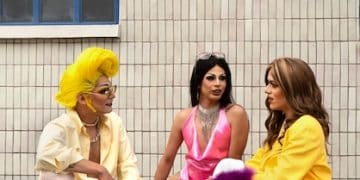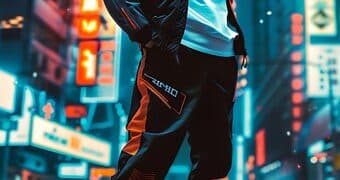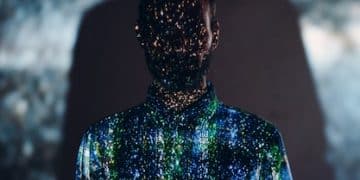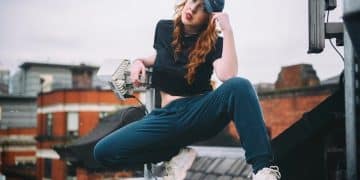Streetwear and Art: Graffiti’s Impact on Modern Fashion
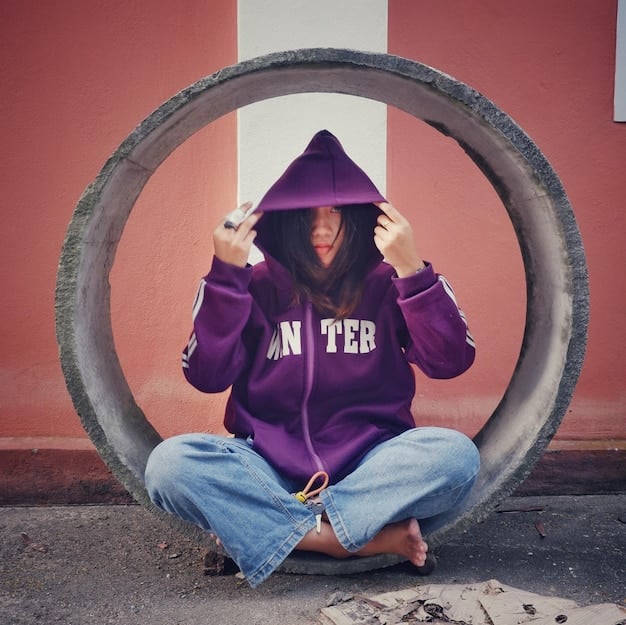
The intertwined histories of streetwear and art, particularly graffiti and street art, reveal how urban creative expressions have profoundly shaped contemporary fashion, imbuing it with authentic cultural narratives and rebellious aesthetics.
From the raw energy of back alleys to the polished runways of global fashion weeks, the relationship between streetwear and art: how graffiti and street art inspire fashion has proven to be one of the most dynamic and enduring sartorial narratives of our time. This connection is not merely superficial; it’s a profound cultural dialogue that has reshaped style, influenced design, and redefined luxury.
The origins of an urban aesthetic: graffiti and its social canvas
Graffiti, often misunderstood as mere vandalism, emerged from the fringes of urban society as a powerful, unsanctioned art form. Its roots lie deep in the socio-economic landscapes of major cities, particularly New York in the 1970s and 80s. This form of expression allowed marginalized communities to claim space, assert identities, and communicate messages on an unprecedented scale, transforming public spaces into a vast, open-air gallery.
The early practitioners, often young individuals with limited resources, used spray paint and marker pens to create intricate tags, throw-ups, and elaborate pieces. These works were not just about aesthetics; they were about visibility, rebellion, and a distinct subcultural pride. This raw, rebellious spirit became inherently attractive, drawing the gaze of those seeking authenticity beyond mainstream culture.
From subway cars to streetwear stores
The journey of graffiti from underground movement to influential fashion motif is a testament to its pervasive cultural impact. As graffiti artists gained notoriety, their distinctive visual language began to permeate other creative fields. Early streetwear brands, often founded by individuals deeply embedded in these urban subcultures, naturally drew inspiration from the art surrounding them.
- Visual Vocabulary: The bold lines, vibrant colors, stylized lettering, and complex compositions of graffiti provided a rich visual vocabulary.
- Authenticity and Edge: Incorporating these elements gave streetwear an inherent authenticity and an edgy, rebellious appeal that resonated with a youth culture looking for alternatives.
- Designer Collaboration: Over time, the relationship evolved, leading to direct collaborations between graffiti artists and fashion houses, bridging the gap between street and haute couture.
The influence wasn’t just in direct prints; it was in the attitude, the oversized silhouettes, the utilitarian aspects, and the anti-establishment ethos that mirrored the art form itself.
Street art’s expansion: Beyond the tag, into clothing narratives
While graffiti laid the groundwork, street art broadened the scope of urban artistic expression. Encompassing stencils, paste-ups, murals, and installations, street art moved beyond the anonymity of tagging to often convey overt social or political messages, or simply to beautify neglected spaces. Artists like Banksy, Shepard Fairey (Obey Giant), and KAWS took street art to global prominence, elevating its status and widening its audience.
This evolution mirrored streetwear’s trajectory. As streetwear matured, it sought deeper, more nuanced narratives. Street art provided a platform for these narratives, transforming clothing into wearable canvases that spoke to contemporary issues, cultural identity, and artistic innovation.
The rise of the wearable canvas
One of the most direct ways street art influences fashion is through the concept of the “wearable canvas.” Designers and brands actively seek out street artists to translate their large-scale works onto garments, accessories, and footwear. This isn’t just about printing an image; it’s about transferring the energy, the message, and the unique artistic signature of the street on a portable format.
This dynamic has several key advantages:
- Exclusivity: Limited edition drops featuring artist collaborations create hype and exclusivity, mimicking the ephemeral nature of some street art.
- Storytelling: Each piece carries a story—the artist’s vision, the urban environment it came from, and the cultural commentary it embodies.
- Accessibility: It democratizes art, making it accessible to a wider audience outside of traditional galleries, allowing individuals to literally wear their appreciation for a particular artist or movement.
The interplay is symbiotic: street art gains new platforms and audiences, while streetwear gains artistic credibility and unique, compelling designs that go beyond traditional textile prints.
Iconic collaborations: When artists meet designers
The most compelling evidence of art’s influence on streetwear lies in the myriad collaborations that have defined the genre. These partnerships are not just marketing stunts; they represent a genuine fusion of creative visions, where the street lexicon meets the fashion industry’s production capabilities. These collaborations often blur the lines between art, design, and commerce, producing some of the most sought-after and collectible items in contemporary fashion.
Case studies in cultural fusion
Numerous instances highlight this powerful synergy. One notable example is the ongoing relationship between Supreme and various artists, including KAWS, Futura 2000, and Rammellzee. These collaborations aren’t just about putting an artist’s signature on a tee; they often involve deep dives into archives, creation of new motifs, and the integration of artistic concepts into the brand’s identity.

Another landmark moment was Louis Vuitton’s collaboration with Stephen Sprouse, an artist who brought the vibrant, raw energy of New York graffiti to luxury goods. His iconic graffiti-style monogram prints on Vuitton bags were initially shocking to some, but ultimately proved to be revolutionary, setting a precedent for high fashion embracing street aesthetics. Similarly, brands like Off-White, founded by the late Virgil Abloh, consistently incorporated artistic elements, often drawing from industrial design, graphic design, and graffiti-esque typography, further solidifying streetwear as a legitimate art form.
These collaborations serve as cultural bridges, introducing street art to new audiences while imbuing fashion pieces with a narrative depth that transcends mere clothing. They demonstrate that the raw, creative energy born on asphalt and brick can be meticulously translated into highly coveted commodities without losing its soul.
The aesthetic language: How art translates to fabric
Beyond direct collaborations, the aesthetic language of graffiti and street art profoundly influences streetwear design at a fundamental level. This influence manifests in various elements, from color palettes and graphic applications to silhouettes and material choices. The urban environment itself, with its layers of tags, murals, and textured surfaces, becomes a muse for designers.
Key aesthetic translations
- Bold Graphics and Typography: The distinctive lettering styles, dynamic compositions, and large-scale graphics inherent in graffiti are consistently replicated in streetwear. Think of oversized logos, intricate text-based designs, and abstract tag-like patterns on hoodies, t-shirts, and jackets.
- Vibrant Color Palettes: Graffiti often employs high-contrast, vivid colors to ensure visibility and impact. This aggressive use of color is a hallmark of many streetwear collections, breaking away from traditional, subdued fashion norms.
- Distressed and Raw Finishes: The weathered, imperfect nature of street art – peeling paint, exposed brick, natural wear and tear – finds its echo in distressed denim, intentionally faded fabrics, and raw edge finishes in streetwear. This aesthetic communicates an authenticity and a lived-in feel, directly referencing the urban canvas.
- Patchwork and Deconstruction: The layered, improvisational nature of street art, where new pieces cover old ones, inspires deconstructed garments, patchwork designs, and mixed-material constructions, creating a visually rich, textured look.
These aesthetic choices are not random; they are deliberate nods to the street’s visual grammar, allowing streetwear to communicate its roots and cultural allegiances.
From counter-culture to mainstream: The evolving perception
What began as a subversive, counter-cultural phenomenon has steadily infiltrated the mainstream, changing perceptions of both art and fashion. Graffiti and street art, once considered illicit acts, are now widely recognized as legitimate artistic expressions, commanding high prices in galleries and auction houses. Similarly, streetwear, once confined to niche skate and hip-hop communities, has become a multi-billion dollar industry, influencing global fashion trends and luxury brands.
Bridging the gap: Accessibility and acceptance
This shift in perception is multifaceted. The internet and social media have played a crucial role in disseminating street art globally, exposing it to a wider audience and fostering appreciation. Fashion, ever-eager to tap into authentic cultural movements, provided a powerful vehicle for this crossover. By incorporating street art elements, streetwear brands acted as cultural translators, making these art forms more accessible and palatable to a broader consumer base.
- Global Reach: Social media platforms allow street artists to share their work with millions instantly, bypassing traditional gatekeepers.
- Brand Legitimacy: Collaborations with major brands lend an air of legitimacy to both the artists and the streetwear movement.
- Consumer Demand: The desire for unique, authentic, and culturally resonant clothing drives demand for artist-inspired streetwear.
This evolution underscores a broader cultural shift: the increasing fluidity between high and low culture, and the recognition that authentic creativity can emerge from any corner of society, regardless of its traditional institutional validation.
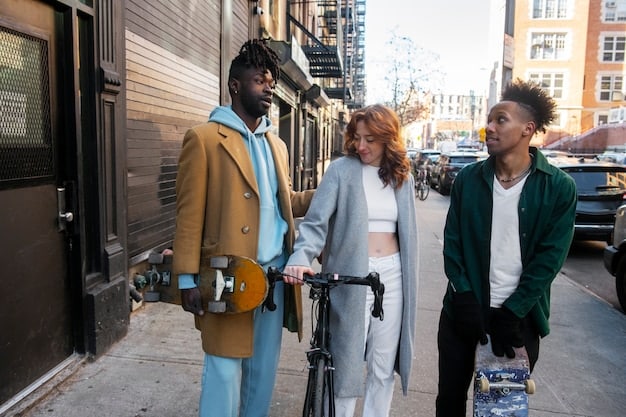
The future of artistic influence in streetwear
The relationship between streetwear and urban art is not static; it continues to evolve, pushing boundaries and exploring new frontiers. As technology advances and societal norms shift, so too will the ways in which these two creative domains intersect.
Digital art and virtual fashion
The rise of digital art, NFTs (Non-Fungible Tokens), and the metaverse presents a fascinating new canvas. Street artists are now creating digital works that can be “worn” in virtual realities, blurring the lines between physical and digital fashion. This opens up possibilities for entirely new forms of artistic expression and fashion consumption that are not bound by physical limitations.
For instance, an artist’s signature tag could become a unique digital overlay for an avatar’s jacket, or an entire virtual gallery could be designed to showcase wearable digital art. This digital frontier promises to further democratize art and fashion, making it even more accessible and interactive.
Moreover, sustainability is becoming an increasingly important factor. Street art’s ethos of repurposing and utilizing existing structures could influence more sustainable practices in streetwear production, from upcycling materials to creating less waste. The future will likely see a continued dialogue, with both art and fashion influencing and adapting to emerging cultural and technological landscapes.
| Key Point | Brief Description |
|---|---|
| 🎨 Graffiti’s Roots | Began as a rebellious urban expression, providing raw visual language for streetwear. |
| 🖼️ Street Art’s Evolution | Expanded beyond tags, fostering wearable canvases and narrative-driven designs. |
| 🤝 Iconic Collaborations | High-profile artist-brand partnerships bridge high fashion and street culture. |
| 🚀 Future Trends | Digital art and virtual fashion will continue to shape streetwear’s artistic frontier. |
Frequently asked questions about streetwear and art
▼
Graffiti’s raw, rebellious aesthetic and its vibrant, distinctive lettering provided a unique visual language. Early streetwear brands, rooted in urban culture, naturally drew upon these elements, incorporating graffiti-inspired graphics and an anti-establishment ethos into their designs, connecting directly with youth counter-culture.
▼
Graffiti often refers to stylized lettering and tags, focusing on personal expression and territory marking. Street art encompasses broader public art forms like stencils, murals, and installations, often with overt social messages. In fashion, graffiti influences bold graphics and typography, while street art impacts wearable canvases and conceptual narratives.
▼
While some argue authenticity can be diluted, successful collaborations demonstrate it’s possible. When high fashion genuinely engages with artists and respects the art form’s origins, it often results in innovative pieces that bridge cultural divides and bring street art to new audiences, enriching both realms rather than exploiting them.
▼
Artists like KAWS, Shepard Fairey (Obey Giant), and Futura 2000 remain highly influential, often collaborating with major streetwear and luxury brands. Their distinctive styles and ability to translate urban art onto different mediums continue to shape contemporary fashion aesthetics and drive consumer demand for unique, artist-driven designs.
▼
Digital art, NFTs, and the metaverse are creating new frontiers for streetwear. Artists can design virtual garments or unique digital patterns for avatars, blurring the lines between physical and digital fashion. This allows for new forms of expression and consumption, pushing the boundaries of what “wearable” art can be.
Conclusion
The synergy between streetwear and urban art, particularly graffiti and street art, is far more than a trend; it’s a testament to the transformative power of creativity when it spills from the margins into the mainstream. It speaks to the enduring search for authenticity, expression, and rebellion in an increasingly homogenized world. As cities continue to evolve and new forms of artistic expression emerge, this vital relationship will undoubtedly continue to inspire and redefine the aesthetics of modern fashion, creating a legacy of style that is as dynamic and vibrant as the streets themselves.
